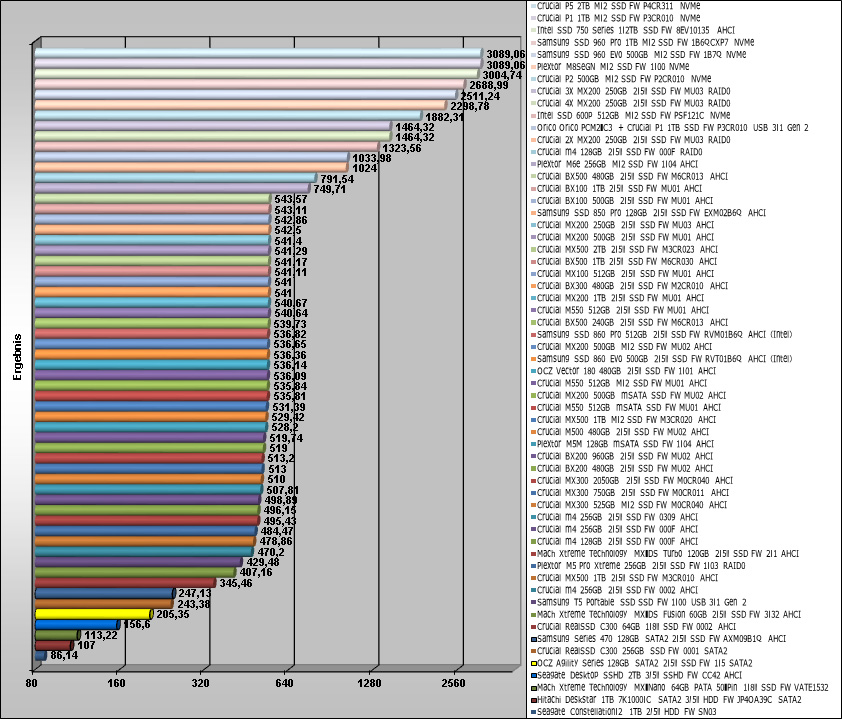
Let us continue with the benchmark results. SATA3 drives are currently tested with an ASRock 890GX Extreme3 motherboard. At present, Microsoft Windows 7 Ultimate Edition is used as the operating system.
The SSD drive speed was examined and compared with the following benchmark software:
AS SSD Benchmark 1.4.3704.27281 – Download
ATTO Disk Benchmark v2.46 – Download
CrystalDiskMark 3.00 – Download
HD Tach 3.040 – Download
SiSoftware Sandra 2011 – Download
The AS-SSD benchmark values offers a very good reference point of the maximal possible reading and writing performance, the speed with smaller files and the respective access time.
1x SSD achieved at the SATA3 controller in RAID mode like in the IDE mode even with correct alignment a significantly slower performance than in AHCI mode. We already published comparative tests of the SSD in IDE mode and in RAID mode and in AHCI mode in previous reviews. Now it is about how fast 1x Plextor M5 Pro Xtreme 256 GB vs 2x Plextor M5 Pro Xtreme 256 GB are in hardware RAID and compare these results among others with 2x Crucial m4 128 GB in RAID. In addition, we test a 2x Plextor M5 Pro Xtreme 256 GB SSDs as software RAID.
In RAID 0 you can see particulary the strong increasement of the sequential transfer rates:
1x Plextor M5 Pro 256GB SSD AHCI reached a read value of 511,21 MB/s and a write value of 436,73 MB/s.
2x Plextor M5 Pro 256GB SSDs reached as hardware RAID 0 a sequential read value of 745,48 MB/s and the highest write value of 604,19 MB/s.
Who now believes that a software RAID with latest processors nowadays is still slower than a chipset hardware RAID, can recognize the opposite in the AS SSD software RAID benchmarks:
2x Plextor M5 Pro 256GB SSDs reached a gigantic high read value of 910,19 MB/s and 818,68 MB/s write value as software RAID 0. However these high values attend a faulty alignment and the missing TRIM support, which will result in decreasing transfer rates. So we test the SSD in a software RAID only out of competition and do not include the results in the official SSD benchmark chart. Nevertheless there are impressive transfer rates, which can be achieved usually only with a “real” hardware RAID controller.
2x Crucial m4 128 GB SSDs reached compared to the hardware RAID 0 a read value of 748,22 MB/s and a write value of 377,24 MB/s.
Here is a Snipping screenshot of the AS SSD benchmark results (1x Plextor M5 Pro Xtreme 256GB SATA3 AHCI):
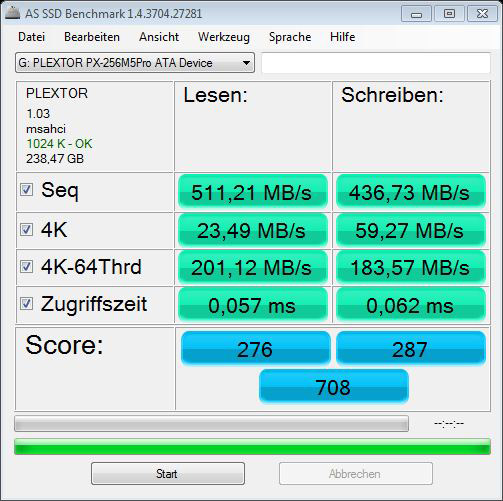
Here is a Snipping screenshot of the AS SSD benchmark results (2x Plextor M5 Pro 256GB at SATA3 RAID as RAID0 64KB):
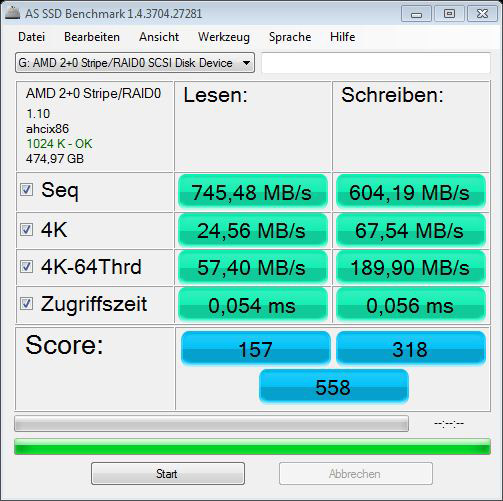
Here is a Snipping screenshot of the AS SSD benchmark results (2x Crucial m4 128GB at SATA3 RAID Controller as RAID0 64KB):
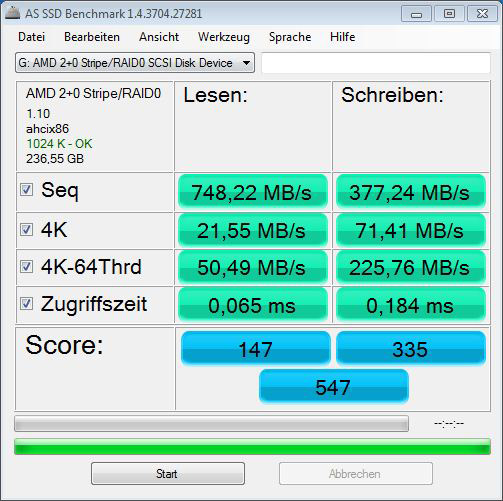
Here is a Snipping screenshot of the AS SSD benchmark results (2x Plextor M5 Pro 256GB at SATA3 AHCI as Software RAID0 64KB):
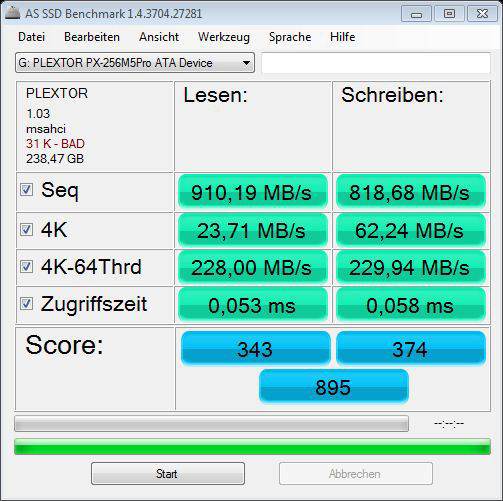
Regarding the total score, the Plextor M5 Pro 256GB reached in AS-SSD at SATA3 AHCI 708 points, which is a clearly above the result of the two Plextor M5 Pro 256GB combined in RAID 0 with 558 points.
It may confuse one or the other, why the RAID array has achieved only the lowest total score with such high transfer rates. This is due to the very high weighting of the “4K 64Thrd” values in the AS-SSD Benchmark tool. 4K means that small 4K blocks are read and/or written and with the 4K 64Thrd this is distributed on 64 Threads at the same time. Thus the benchmark program simulate for example a typical program start. And exactly where the problem is for a SSD RAID 0, which can be achieve significantly higher transfer rates, but the everyday Windows performance of SSD remains on track.
How big the difference is, becomes even clearer in the iops value comparison where the data input and output performance of 51486 drops to 14695 and thus delays the fast file access, even with the increased 16MB from 31,95 iops to 46,59 iops.
Here is a Snipping screenshot of the AS SSD iops benchmark results (1x Plextor M5 Pro Xtreme 256GB SATA3 AHCI):
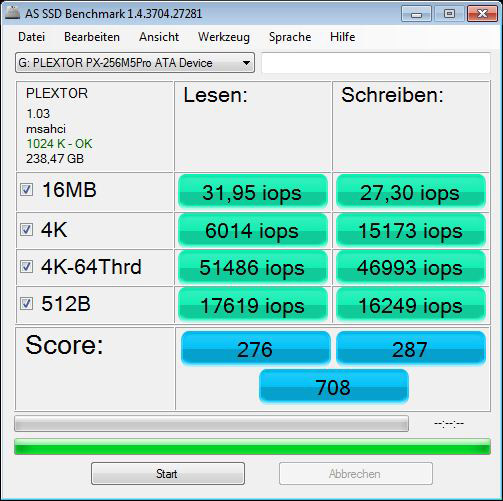
Here is a Snipping screenshot of the AS SSD iops benchmark results (2x Plextor M5 Pro 256GB at SATA3 RAID as RAID0 64KB):
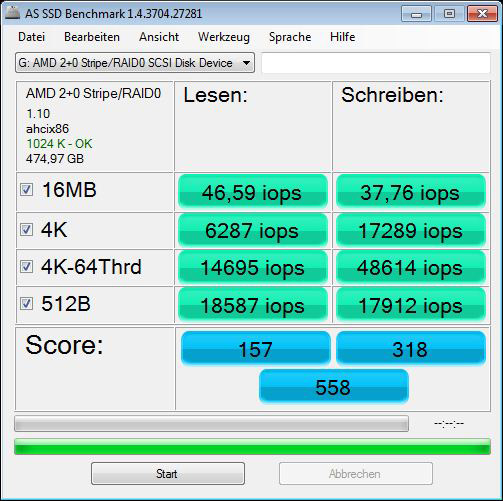
The comparison of the AS SSD benchmark results is extended with each new HDD/SSD test. Here you can see already some SSDs in comparison to both Plextor M5 Pro Xtreme 256 GB 2.5″ SSDs, whereby the SSD benchmark chart is updated continuously with new SSDs. The top of the AS SSD total score is led by the Plextor M5 Pro Xtreme 256 GB SSD, where the RAID 0 has a clearly lower overall result, because of the lower 4K values.
Here is a comparison of the AS SSD benchmark values, which are getting updated with soon coming drives:
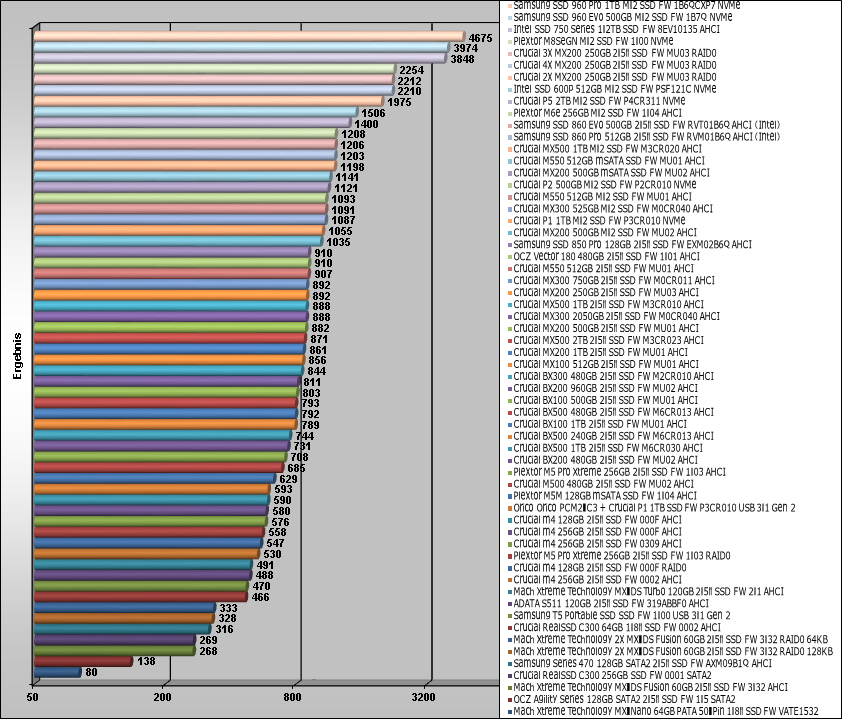
The ATTO disk benchmark values gives a very good overview about the write and read rate on different file sizes. These values are maximum ratings, which are different to the previously continuous transfer rate benchmarks, since this benchmark may even reach a higher overall performance with slower SSDs.
Here is a Snipping screenshot of the ATTO Disk benchmark values (1x Plextor M5 Pro Xtreme 256GB SATA3 AHCI):
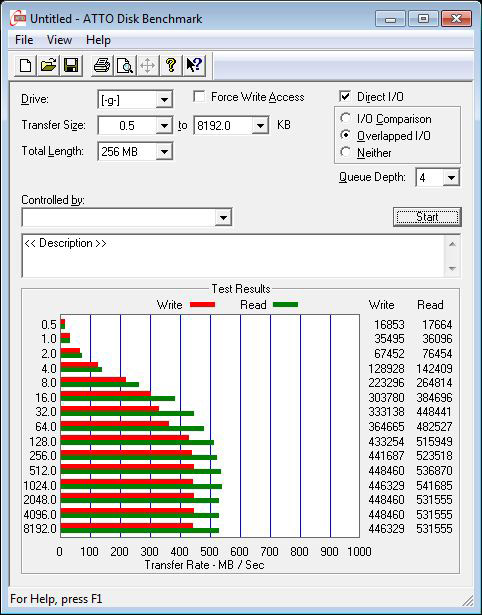
Here is a Snipping screenshot of the ATTO Disk benchmark values (2x Plextor M5 Pro 256GB SATA3 RAID as RAID0 64KB):
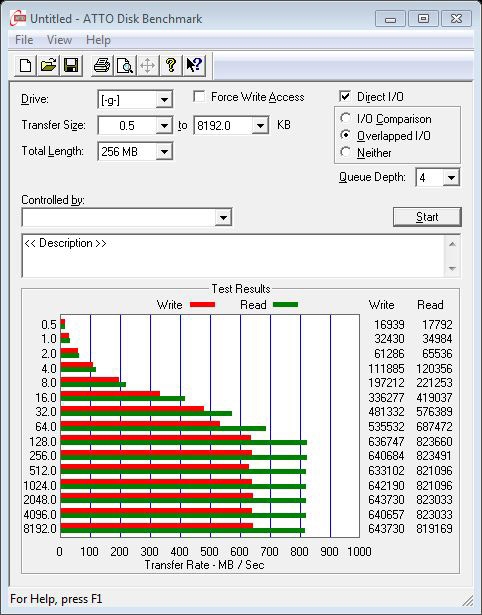
The Plextor M5 Pro Xtreme 256 GB SSD (green) already reached a good read speed at about 16 KB transfer size and the highest transmission values of up to 536870 KB/s at about 128 KB transfer size. The write speed (red) achieved high values at a transfer size of approx. 32 KB and the highest transfer rate up to 448460 KB/s at a transfer size of about 256 KB. With 2x Plextor M5 Pro Xtreme 256 GB SSDs in RAID 0 the values are significantly higher. In our case, a read speed (green) of up to 823660 KB/s and a write speed (red) up to 643730 KB/s can be achieved.
The ATTO disk benchmark values are compared with a small transfer size of 32KB and a large transfer size of 8192KB. The bar chart already includes a comparison to some SSDs and HDDs, where the Plextor M5 Pro Xtreme cannot reach the top.
Here is a comparison of the ATTO disk benchmark values, which are getting updated with soon coming drives:
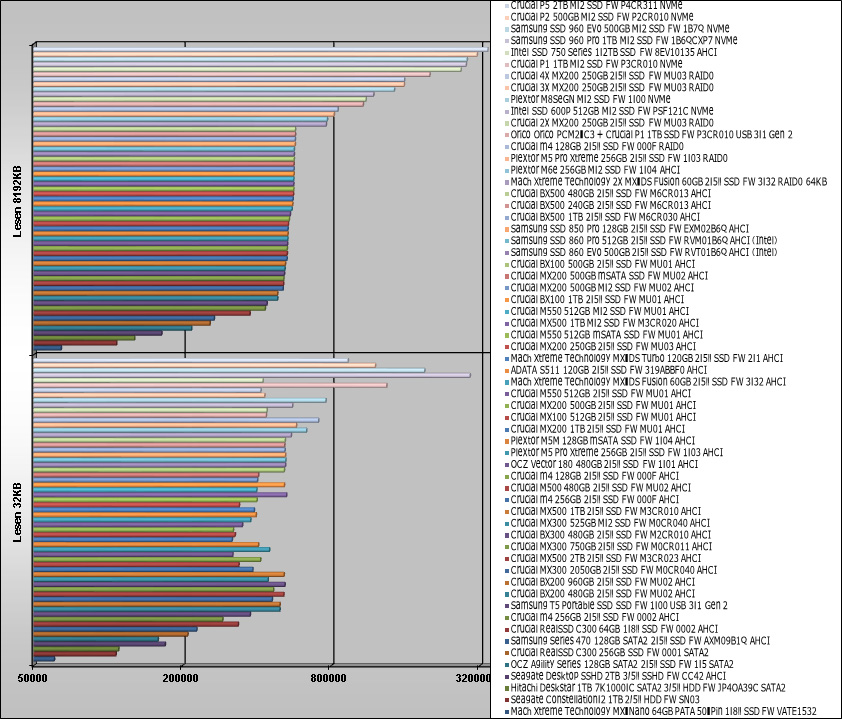
With CrystalDiskMark one receives a balanced measurement of the performance with different transfer sizes.
Here is a Snipping screenshot of the CrystalDiskMark values (1x Plextor M5 Pro Xtreme 256GB SATA3 AHCI):
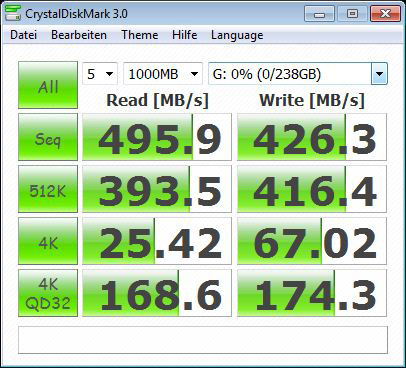
Here is a Snipping screenshot of the CrystalDiskMark values (2x Plextor M5 Pro 256GB at SATA3 RAID as RAID0 64KB):
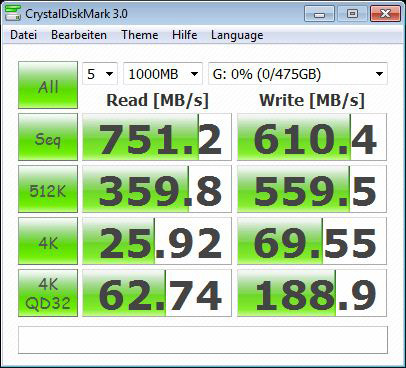
The following diagram shows the CrystalDiskMark results once again compared with other SSDs and platter drives, which are extended step by step. In the CrystalDiskMark comparison one can see significant differences between the to-date tested Solid State Drives and Hard Disk Drives.
As seen in the previous 4K-64Threads results, the read 4K QD32 value is nearly one third slower. But the sequential read and write result of both Plextor M5 Pro Xtreme SSDs is much higher when operating as RAID0.
Here is a comparison of the CrystalDiskMark values, which are getting updated with soon coming drives:
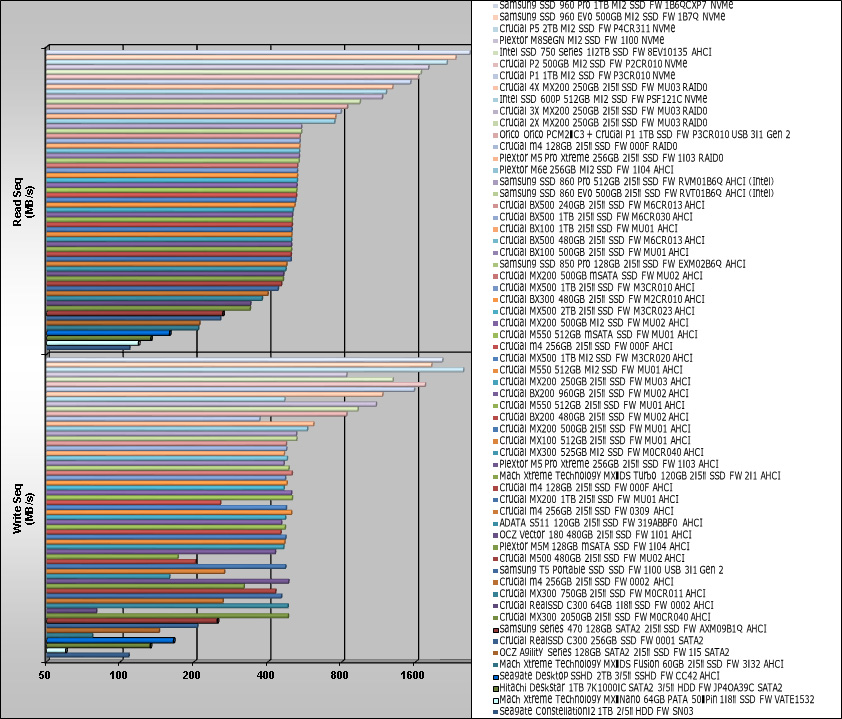
With HD Tach one can measure the gradient of the performance, but the SSD transfer is not comparable with a conventional HDD. New logical NAND cell access of the SSD controller results like some other equal designed SSDs in strong varying values with the latest HD Tach Version 3.0.4.0 version, which is written for hard disk drives. HD Tach measured with the two Plextor M5 Pro Xtreme 256 GB SSDs in RAID0 varying read and write rates and extremely low access times of approx. 0.1ms. To compare these results you can move the mouse over the following drives to see their respective benchmark results:2x Plextor M5 Pro Xtreme 256GB 2,5″ SSD an SATA3 RAID0, Plextor M5 Pro Xtreme 256GB 2,5″ SSD at SATA3 AHCI, ADATA S511 120GB SSD at SATA3 AHCI, ADATA S511 120GB SSD at SATA3 AHCI, 2x Crucial m4 128GB 2,5″ SSD at SATA3 RAID, Crucial m4 128GB 2,5″ SSD at SATA3 AHCI, Crucial m4 128GB 2,5″ SSD at SATA3, Crucial m4 256GB 2,5″ SSD FW 000F at SATA3 AHCI, Crucial m4 256GB 2,5″ SSD FW 0309 at SATA3 AHCI, Crucial m4 256GB 2,5″ SSD FW 0002 at SATA3 AHCI, Crucial m4 256GB SSD FW 0309 at SATA3 IDE, Crucial m4 256GB 2,5″ SSD FW 0002 at SATA3, Crucial M500 480GB 2,5″ SSD at SATA3 AHCI, Crucial C300 64GB 1,8″ SSD at SATA3, Crucial RealSSD 256GB 2,5″ SSD at SATA3, Crucial RealSSD 256GB 2,5″ SSD at SATA2, Hitachi 7K1000.C 1TB HDD, MX-DS Fusion 60GB SSD SATA3 IDE, MX-DS Fusion 60GB SSD SATA3 IDE, MX-DS Turbo 120GB SSD at SATA3 AHCI, OCZ Agility 128GB SSD, Samsung Series470 128GB SSD AHCI, Samsung Series470 128GB SSD Legacy IDE, Seagate Constellation.2 1TB 2,5″ HDD at SATA3, Toshiba MK8007GAH 1.8″ hard disk drive.
Here is a Snipping screenhot of the HD Tach benchmark values:
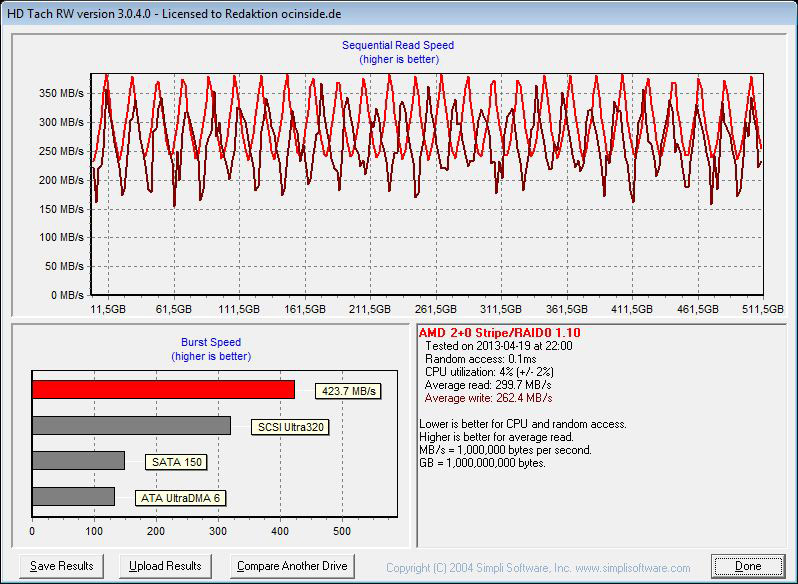
The comparison of HD tach benchmark results shows the fast read speed, write speed and the low average access time of the two Plextor M5 Pro Xtreme 256GB SSDs as RAID0 array.
Here is an impressive comparison of the HD Tach benchmark values, which are getting updated with soon coming drives:
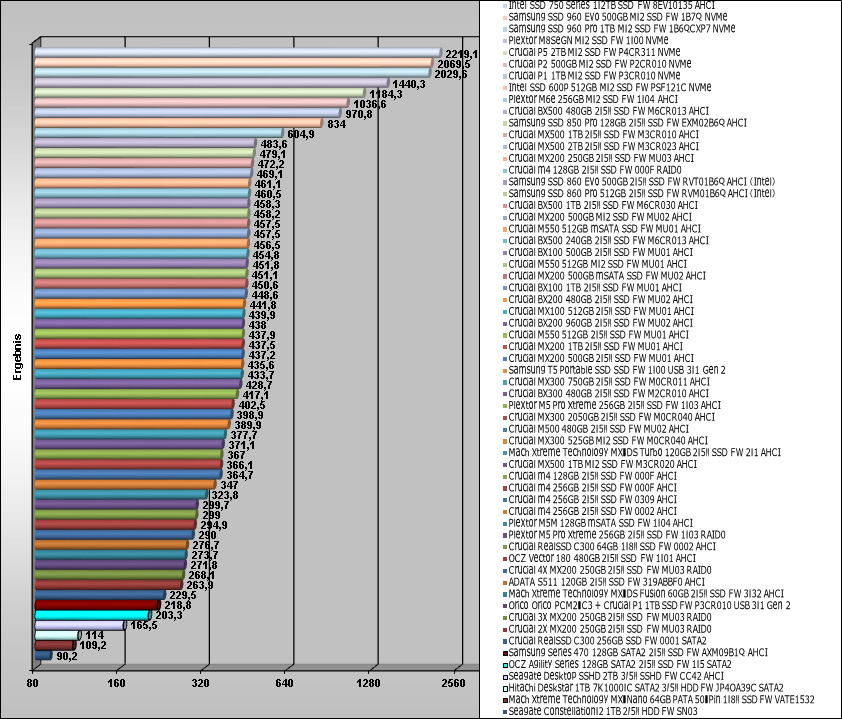
SiSoftware Sandra benchmark result
Of course, SiSoftware Sandra benchmark should not be missing in this test series. SiSoftware offers with their SiSoft Sandra program a very comprehensive tool, which contains a lot of tools to get very reliable test results of all hardware components.
Here is a Snipping screenshot of the SiSoftware Sandra benchmark read values (1x Plextor M5 Pro Xtreme 256GB SATA3 AHCI):

Here is a Snipping screenshot of the SiSoftware Sandra benchmark read values (2x Plextor M5 Pro 256GB as RAID0 64KB):

Here is a Snipping screenshot of the SiSoftware Sandra benchmark write values (1x Plextor M5 Pro Xtreme 256GB SATA3 AHCI):

Here is a Snipping screenshot of the SiSoftware Sandra benchmark write values (2x Plextor M5 Pro 256GB as RAID0 64KB):

Here is a comparison of the SiSoftware Sandra benchmark values, which are getting updated with soon coming drives:
